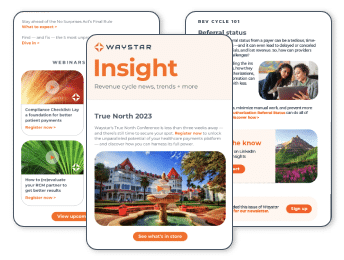The digital side of healthcare has evolved to become a critical component of any provider’s rev cycle — just as digital experiences are now standard in other industries, such as retail or banking. There are now more digital touchpoints for patients than ever. Even when patients are just looking for a doctor it’s increasingly common for them to start at a browser window, with a 2019 Healthcare Consumer Insight survey finding more than 60% of patients start their search online.
More patients than ever start their healthcare journey online
Virtual touchpoints overall are becoming even more important in the wake of the pandemic. Per a recent survey from the American Journal of Preventive Medicine, there was a 20-fold increase in telemedicine use after March 13, 2020. Conversely, office-based encounters declined by nearly 50%.
When you consider just how much of the patient experience is moving online, it becomes clear just how crucial an effective patient portal is for any provider. But while many providers do currently offer some kind of patient portal, healthcare still has a ways to go to catch up with the consumer-facing digital tools that patients are used to in other industries.
In fact, while the Government Accountability Office (GAO) found in 2017 that nearly 90% of providers were already offering patient portals, less than a third of their patients used it. Another report from the Office of the National Coordinator for Health Information Technology, found their respondents only offered 52% of patients online access to their records, of which only 28% took advantage of the option.
Why effective communication is key
So why are people so hesitant to use the portals providers are offering? One factor to consider is providers often do not treat their portal as an integral component in the patient experience, let alone a critical part of their communication strategy. This means that while a portal might exist, a patient may be completely unaware of it. And if they are informed of it, it’s often not explained properly or introduced with any sort of primer on the tools that could greatly benefit them.
If providers are not approaching their patient portals with a comprehensive communications strategy, they will not see the patient engagement — or patient payments—they hope to. In other words, whether you already have a patient portal or are looking to acquire one, you’ll need to integrate it fully into not just your existing systems, but also your communication strategy and the patient experience as a whole.
That means introducing info on the portal as early as possible, offering clear and concise directions that are easy to find, and making it as simple as possible for your patients to access. Offer reminders during visits, include links when emailing bills, and make sure staff is available to field questions — these are all simple steps you can take for a more comprehensive communication strategy that ensures patients are informed and educated about the portal.
Is your patient portal up to the challenge ahead?
It’s also important to remember that not all patient portals are created equal. Users are just as likely to avoid using one if they think it’s too confusing, not capable of completing a desired task, or in general just a waste of time — all of which seem to be the stereotypes many people have about their portals.
And who could blame them? Review enough portals and the disparity in quality quickly becomes apparent: outdated or clunky interfaces, available data or information that is not current or completely incorrect, long navigation trees, or confusing prompts — they all add up to experiences that tend to scare patients away. And all it takes is one bad experience to sour them on any future use.
Finally, it’s important to remember you’ll need proper security protocols to reassure patients their data will be protected, even when accessed online. How important is that sense of safety to patients? A recent study found that nearly half of Americans are ready to embrace telehealth but are still concerned about their health data being exposed. In other words, you need to not just take the necessary precautions to protect their data, but also take time to explain what protections are in place and why patients should be able to trust your portal.
The wrap up
When deciding which patient portal to use, providers should choose one designed for healthcare with the type of functionality that creates user adoption. From the patient’s point of view, that means an intuitive interface, simple navigation, and easy access to useful tools to manage their payments and account. And while selecting the right patient portal is key, providers can only get the most out of that portal if they approach it as part of a comprehensive patient engagement strategy.
Found this post helpful? Learn about the top five things your patients want from the billing process.


